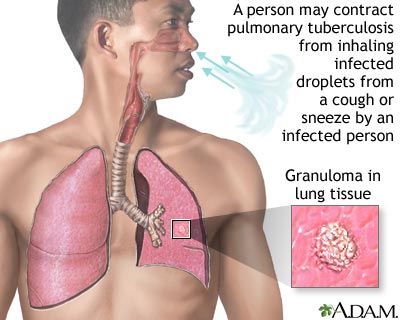 Tuberculosis is a chronic infectious disease in 90% of cases affect the pulmonary system, and in 10% – and other organ systems (central nervous system, heart, eyes, skin, organs of the abdominal cavity, bones and joints, Uro-genital system etc.).
Tuberculosis is a chronic infectious disease in 90% of cases affect the pulmonary system, and in 10% – and other organ systems (central nervous system, heart, eyes, skin, organs of the abdominal cavity, bones and joints, Uro-genital system etc.).
in the past, disease was a problem in the population of poor countries. Today, tuberculosis is widespread in almost all developed countries in the world.
The germ of tuberculosis is Mikobakterium tuberkulozis (Koch’s bacterium), which is characterized by considerable resistance in the external environment, especially long remained separated in sputum of patients, even after their drying.
Most people who become infected with TB bacteria are able to “fight” with them and stop their growth – bacteria remain to live in the body of an infected person, but not active. after a while it can be activated by itself. This condition is called hidden tuberculosis infection – people with a hidden infection not identified the disease symptoms and can not infect others.
Sources of infection may be tuberculosis humans and animals (mainly cattle, less pigs, poultry, etc.) and their products.
Penetration of the infection most often occurs in the airways. Coughing, sneezing, conversation sick pay tuberculosis bacilli into the air. Airborne by coughing and expectoration people in the vicinity could be infected directly by airborne means. in the sputum of patients contains millions of bacteria. Infection can be prenese by dust in the rooms and streets where tuberculosis bacteria remain viable for a long time.
Infection with tuberculosis is possible dietary: by consuming milk from diseased cows or products made from it; consumption of raw or inadequately cooked infected eggs, for use nanedostatachno heat-treated meat from sick birds and pigs.
it is possible, though rare, infection with tuberculosis to become a contact time in the damaged skin and mucous membranes, which is typical for people with occupations related to farming.
Direct contact with someone with tuberculosis;
Smoking and alcohol abuse;
Comorbidities, such as: chronic nonspecific lung diseases (chronic bronchitis, silicosis bronhoektazii), diabetes ulcers of the stomach, mental illness, and other allergic conditions;
Lack of vaccination against tuberculosis or poor implementation of same;
Reduced resistance capabilities of the organism as a result of: spent infections (measles, whooping cough, flu and flu-like conditions, etc..) Malnutrition (especially protein deficiency in food) ihipovitaminozi, unsanitary working conditions and lifestyle, puberty, pregnancy and lactation;
Carriers of HIV.
Symptoms include:
Cough that can last weeks, beginning in a slight cough and progresses in the disease process and increases the cough becomes wet;
Expectoration – the sick pay mainly morning phlegm, sometimes mixed with blood;
Fever – the patients have fever for an extended period of time (even months). it is possible that the disease can proceed without fever;
Sweating – it was plenty, especially at night;
Chest pain – they occur in most patients between the shoulder blades in the shoulder and lateral chest while enhancing breathing and cough;
Anorexia – it leads to weight reduction;
Shortness of breath – this feature is characteristic of advanced stages of disease;
Fatigue and frustration – these symptoms continue longer.
Tuberculosis can occur completely asymptomatic in about 15% of cases. in adults often resembles pneumonia or other infectious disease.
The worst problem – and the easiest to solve – is bad diagnosis. Over 80% of all cases are concentrated in 22 countries, 9 of which are in Africa, 11 in Asia and Russia. Nearly 40% of all cases in these countries remain untreated. it is estimated that 1.4 million people suffer from both HIV / AIDS and tuberculosis, but only a quarter of them were found. HIV increased 20-fold Russian tuberculosis.
Most types of TB can be cured with drugs for 10 euros, if diagnosed in time. in patients who are late to start treatment, microbes can develop resistance to most common drugs. Treatment can cost thousands of dollars and take two years, with no guarantee of success. “Without significant investment in technology and opportunities for prevention, diagnosis and treatment, sustained virus strain may become dominant in the coming decades,” warns the study.